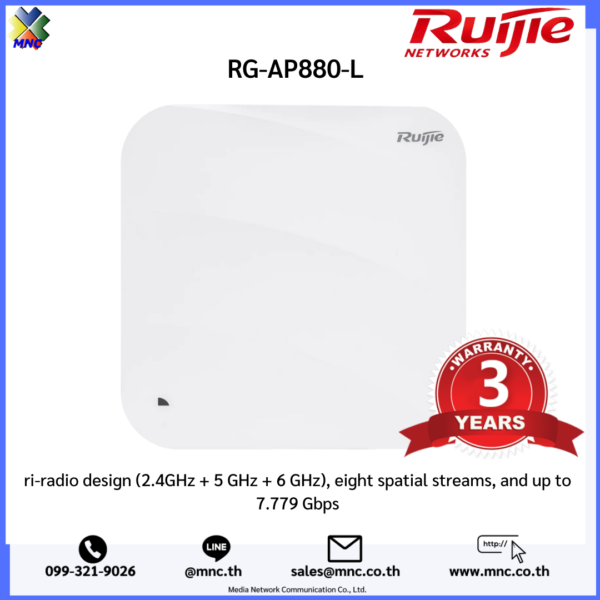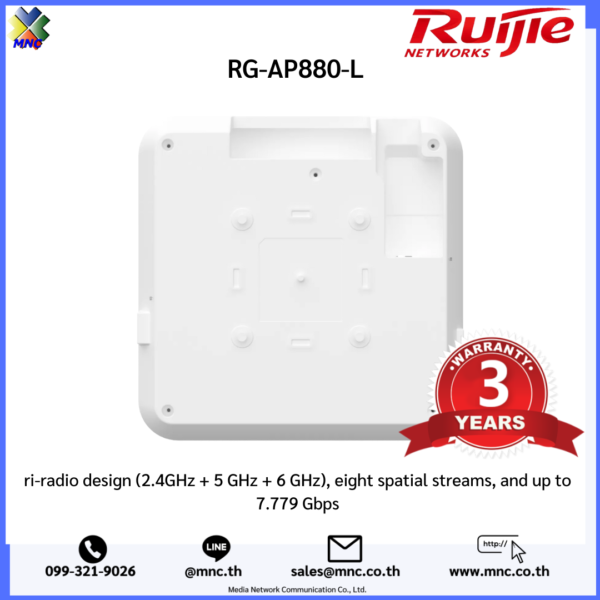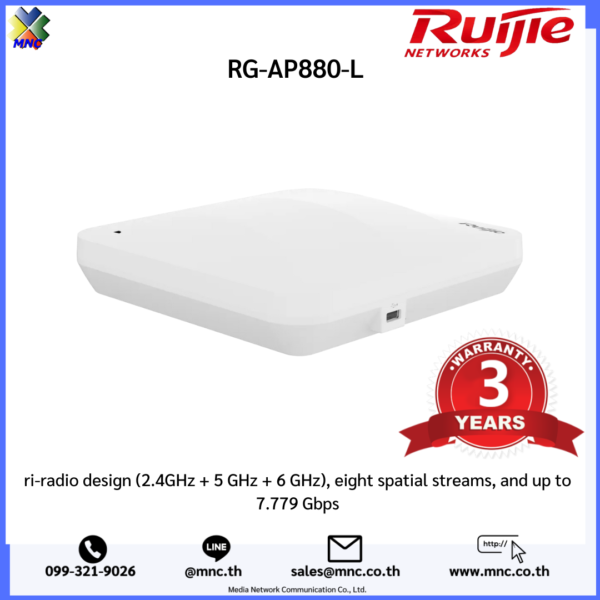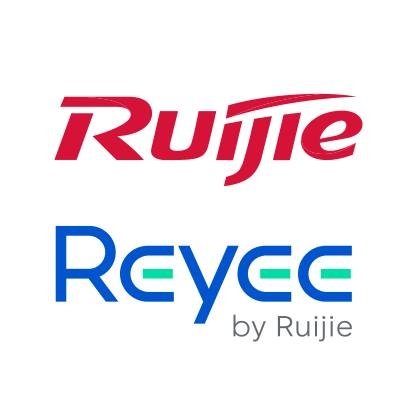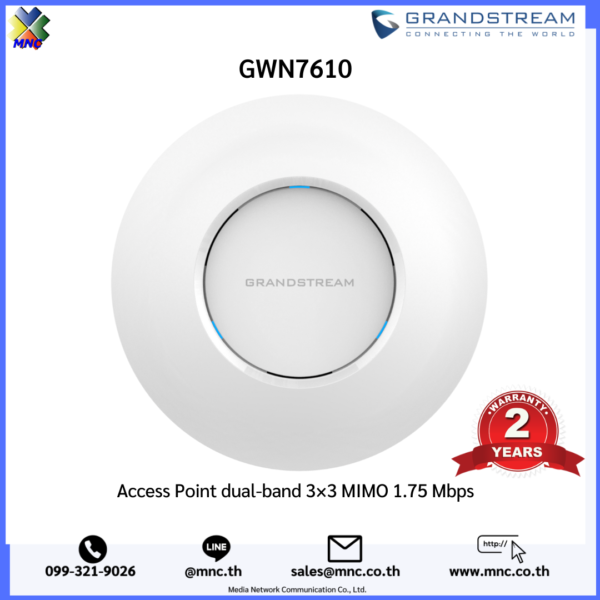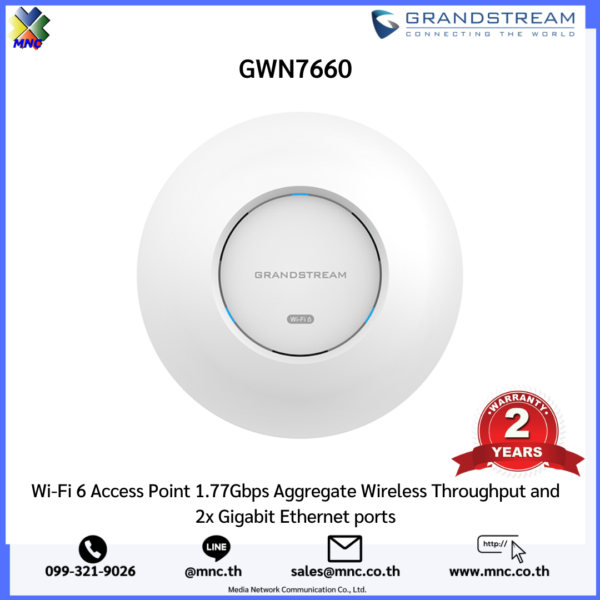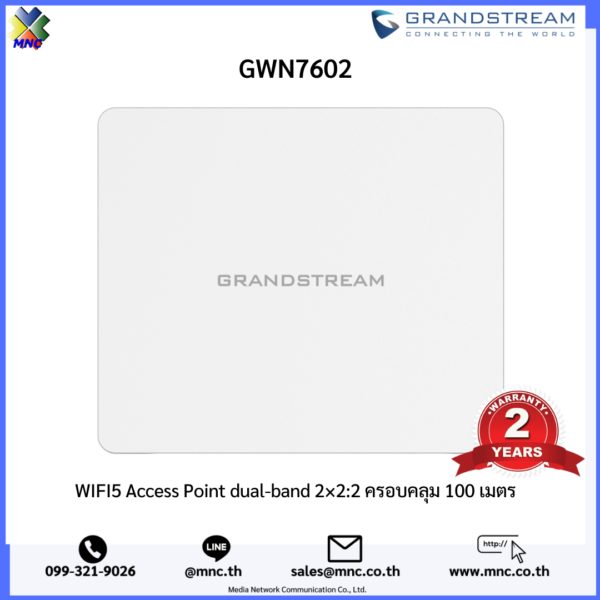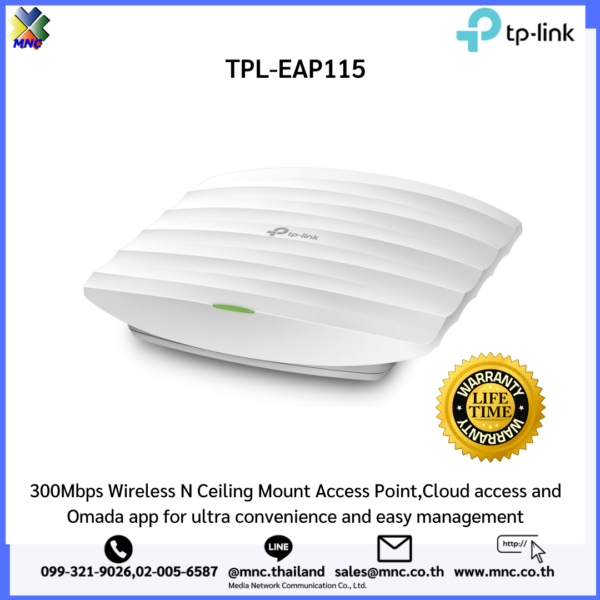คำอธิบาย
Ruijie RG-AP880-L
Specifications
| Dimensions and Weight | RG-AP880-L |
| Unit dimensions
(W x D x H) |
230 mm x 230 mm x 51 mm (9.1 in. x 9.1 in. x 2.1 in.) |
| Shipping dimensions
(W x D x H) |
284 mm x 262 mm x 124 mm (11.2 in. x 10.4 in. x 4.9 in.) |
| Unit weight | Main unit: 1.0 kg (2.2 lbs)
Mounting bracket: 0.1 kg (0.22 lbs) |
| Shipping weight | 1.25 kg (2.76 lbs) |
| Mounting | Wall/Ceiling-mount (a mounting bracket is delivered with the main unit) |
| Lock option | Kensington lock and securing latch |
Wi-Fi Radio
| Wi-Fi Radio | RG-AP880-L |
| Radio design | Tri-radio and up to eight spatial streams:
● Radio 1: 2.4GHz: Two spatial streams, 2×2 MU-MIMO ● Radio 2: 5GHz: Two spatial streams, 2×2 MU-MIMO ● Radio 3: 6GHz: Four spatial streams, 4×4 MU-MIMO |
| Operating frequencies | Radio 1: 802.11b/g/n/ax
● 2.400 GHz to 2.483 GHz, channels 1 to 13 Radio 2: 802.11a/n/ac/ax ● 5.150 GHz to 5.250 GHz, U-NII-1, channels 36, 40, 44, and 48 ● 5.250 GHz to 5.350 GHz, U-NII-2A, channels 52, 56, 60, and 64 ● 5.470 GHz to 5.725 GHz, U-NII-2C, channels 100, 104, 108, 112, 116, 120, 124, 128, 132, 136, and 140 ● 5.725 GHz to 5.850 GHz, U-NII-3/ISM, channels 149, 153, 157, 161, and 165 Radio 3: 802.11ax ● 5.925 GHz to 7.125 GHz, U-NII-4, channels 1 to 233 Note: Country-specific restrictions apply. |
| Data rates | Combined peak data rate: 7.779 Gbps
Radio1: 2.4 GHz: ● Two spatial stream Single User (SU) MIMO for up to 574 Mbps wireless data rate to 2SS HE40 802.11ax client devices (max.) ● Two spatial stream Single User (SU) MIMO for up to 287 Mbps wireless data rate to 2SS HE20 802.11ax client devices (typical) Radio 2: 5 GHz: ● Two spatial stream Single User (SU) MIMO for up to 2.4 Gbps wireless data rate to individual 4SS HE160 802.11ax client devices (max.) ● Two spatial stream Single User (SU) MIMO for up to 1.2 Gbps wireless data rate to individual 2SS HE80 802.11ax client devices (typical) Radio 3: 6 GHz ● Four spatial stream Single User (SU) MIMO for up to 4.8 Gbps wireless data rate to individual 4SS HE160 802.11ax client devices (max.) ● Two spatial stream Single User (SU) MIMO for up to 1.2 Gbps wireless data rate to individual 2SS HE80 802.11ax client devices (typical) ● Four spatial stream Multi User (MU) MIMO for up to 4.8 Gbps wireless data rate to up to four 1SS or two 2SS HE160 802.11ax DL-MU-MIMO capable client devices simultaneously (max.) ● Four spatial stream Multi User (MU) MIMO for up to 2.4 Gbps wireless data rate to up to four 1SS or two 2SS HE80 802.11ax DL-MU-MIMO capable client devices simultaneously (typical) |
| Data rate set | The following 802.11-compliant data rates in Mbps are supported:
2.4 GHz ● 802.11b: 1, 2, 5.5, 11 ● 802.11g: 1, 2, 5.5, 6, 9, 11, 12, 18, 24, 36, 48, 54 ● 802.11n: 6.5 to 300 (MCS0 to MCS15, HT20 to HT40) ● 802.11ax: 8.6 to 574 (MCS0 to MCS11, NSS = 1 to 2, HE20 to HE40) 5 GHz ● 802.11a: 6, 9, 12, 18, 24, 36, 48, 54 ● 802.11n: 6.5 to 300 (MCS0 to MVC31, HT20 to HT40) ● 802.11ac: 6.5 to 1,732 (MCS0 to MCS9, NSS = 1 to 4, VHT20 to VHT160) ● 802.11ax: 8.6 to 2,402 (MCS0 to MCS11, NSS = 1 to 4, HE20 to HE160)
6 GHz ● 802.11ax:8.6 ~ 4,804 (MCS0 ~ MCS11, NSS = 1 to 4, HE20 to HE160) |
| Packet aggregation | 802.11n/ac/ax: A-MPDU and A-MSDU |
| Antenna type | Built-in omnidirectional antennas (two 2.4 GHz antennas, two 5 GHz antennas and four 6 GHz antennas) |
| Max. antenna gain | 5.9 dBi in 2.4GHz and 6.2 dBi in 5GHz
The downtilt angle for the maximum gain is roughly 30 degrees. With reference to the pattern of each antenna of the MIMO radios, the maximum gain of the effective per-antenna pattern is 3.8 dBi in 2.4 GHz and 4.6 dBi in 5 GHz. |
| Max. transmit power | 2.4 GHz: 27 dBm (24dBm per chain)
5 GHz: 26 dBm (23dBm per chain) 6 GHz: 26 dBm (23dBm per chain) Note: The transmit power is limited by local regulatory requirements. |
| Power increment | Configurable in increments of 1 dBm |
| Radio technologies | 802.11b: Direct-Sequence Spread-Spectrum (DSSS)
802.11a/g/n/ac: Orthogonal Frequency-Division Multiplexing (OFDM) 802.11ax: Orthogonal Frequency Division Multiple Access (OFDMA) |
| Modulation type | 802.11b: BPSK, QPSK, and CCK
802.11a/g/n: BPSK, QPSK, 16-QAM, and 64-QAM 802.11ac: BPSK, QPSK, 16-QAM, 64-QAM, and 256-QAM 802.11ax: BPSK, QPSK, 16-QAM, 64-QAM, 256-QAM, and 1024-QAM |
The following table lists the radio frequency performance of Wi-Fi including different frequency bands, protocols, and date rates. It is country-specific, and Ruijie Networks reserves the right of interpretation.
| Radio Frequency Performance | RG-AP880-L | ||
| Frequency Band and Protocol | Data Rate | Max. Transmit Power per Transmit Chain | Max. Receive Sensitivity
per Receive Chain |
| 2.4 GHz, 802.11b | 1 Mbps | 24 dBm | –96 dBm |
| 2 Mbps | 24 dBm | –95 dBm | |
| 5.5 Mbps | 23 dBm | –93 dBm | |
| 11 Mbps | 22 dBm | –89 dBm | |
| 2.4 GHz, 802.11g | 6 Mbps | 24 dBm | –91 dBm |
| 24 Mbps | 23 dBm | –85 dBm | |
| 36 Mbps | 23 dBm | –80 dBm | |
| 54 Mbps | 21 dBm | –74 dBm | |
| 2.4 GHz, 802.11n (HT20) | MCS0 | 24 dBm | –90 dBm |
| MCS7 | 20 dBm | –70 dBm | |
| 2.4 GHz, 802.11n (HT40) | MCS0 | 24 dBm | –90 dBm |
| MCS7 | 20 dBm | –70 dBm | |
| 2.4 GHz, 802.11ax (HE20) | MCS0 | 24 dBm | –90 dBm |
| MCS11 | 16 dBm | –62 dBm | |
| 2.4 GHz, 802.11ax (HE40) | MCS0 | 24 dBm | –88 dBm |
| MCS11 | 16 dBm | –60 dBm | |
| 5GHz 802.11a | 6 Mbps | 23 dBm | –91 dBm |
| 24 Mbps | 22 dBm | –85 dBm | |
| 36 Mbps | 22 dBm | –80 dBm | |
| 54 Mbps | 21 dBm | –74 dBm | |
| 5GHz 802.11n (HT20) | MCS0 | 23 dBm | –90 dBm |
| MCS7 | 20 dBm | –68 dBm | |
| 5GHz 802.11n (HT40) | MCS0 | 23 dBm | –88 dBm |
| MCS7 | 20 dBm | –68 dBm | |
| 5GHz 802.11ac (VHT20) | MCS0 | 23 dBm | –90 dBm |
| MCS9 | 18 dBm | –68 dBm | |
| 5GHz 802.11ac (VHT40) | MCS0 | 23 dBm | –88 dBm |
| MCS9 | 18 dBm | –63 dBm | |
| 5GHz 802.11ac (VHT80) | MCS0 | 23 dBm | –85 dBm |
| MCS9 | 18 dBm | –60 dBm | |
| 5GHz 802.11ax (HE20) | MCS0 | 23 dBm | –90 dBm |
| MCS11 | 16 dBm | –60 dBm | |
| 5GHz 802.11ax (HE40) | MCS0 | 23 dBm | –86 dBm |
| MCS11 | 16 dBm | –56 dBm | |
| 5GHz 802.11ax (HE80) | MCS0 | 23 dBm | –83 dBm |
| MCS11 | 16 dBm | –53 dBm | |
| 5GHz 802.11ax (HE160) | MCS0 | 23 dBm | –81 dBm |
| MCS11 | 16 dBm | –51d Bm | |
| 6GHz 802.11ax (HE20) | MCS0 | 22 dBm | –90 dBm |
| MCS11 | 16 dBm | –60 dBm | |
| 6GHz 802.11ax (HE40) | MCS0 | 22 dBm | –86 dBm |
| MCS11 | 16 dBm | –56 dBm | |
| 6GHz 802.11ax (HE80) | MCS0 | 22 dBm | –83 dBm |
| MCS11 | 16 dBm | –53 dBm | |
| 6GHz 802.11ax (HE160) | MCS0 | 22 dBm | –81 dBm |
| MCS11 | 16 dBm | –51 dBm | |
Bluetooth Radio
| Bluetooth Radio | RG-AP880-L |
| Bluetooth | Bluetooth 5.1 |
| Antenna type | Integrated vertically polarized omnidirectional antenna |
| Max. antenna gain | 4.6 dBi, with roughly 30 degrees downtilt |
| Max. transmit power | 10 dBm (Class 1) |
| Receive sensitivity | –98 dBm |
Port
| Port | RG-AP880-L |
| Fixed service port | 1 x 100/ 1000/2500/5000Base-T RJ45 Ethernet port with auto-negotiation
● Auto MDI/MDIX crossover ● NBASE-T/IEEE802.3bz-compliant 5 Gbps ● PoE-PD: 54 V DC (norminal vlaue) 802.3af/at/bt(Class 3 or higher) ● 802.3az EEE 1 x LAN1/5GE SFP combo port, compatible with 1GE and 2.5GE SFP 1 x 10/100/1000Base-T RJ45 Ethernet port with auto-negotiation ● Supplying 48 V/12.95 W power to an IoT unit ● Auto MDI/MDIX crossover ● 802.3az EEE |
| Fixed management port | 1 x RJ45 console port (serial console port) |
| USB | USB 3.0 (Type-A connector) |
| Status LED | 1 x multi-color system status LED |
| Button | 1 x Reset button
● Press the button for shorter than 2 seconds. Then the device restarts. ● Press the button for longer than 5 seconds. Then the device restores to factory settings. |
Power Supply and Consumption
| Power Supply and Consumption | RG-AP880-L |
| Input power supply | The AP supports the following two power supply modes:
● 54 V DC/1.1 A power input over DC connector: The DC connector accepts 2.1 mm/5.5 mm center-positive circular plug. A DC power adapter is delivered with the main unit. ● PoE input over LAN 1: The power source equipment (PSE) complies with IEEE 802.3af/at/bt standard (PoE/PoE+/PoE++). Note: ● If both DC power and PoE are available, DC power is preferred. ● When powered by 802.3bt (PoE++), the AP operates with the optimal performance. ● When powered by 802.3at (PoE+), the AP starts up normally. LAN 2 and USB port cannot supply power to external devices. ● When powered by 802.3af (PoE), the AP starts up normally. 2.4 GHz, 5 GHz and 6 GHz radio cards can work only in one spatial stream mode . LAN 2 and USB port cannot supply power to external devices. |
| External power supply | When powered by 802.3bt (PoE++), the AP can supply power to an external device.
● The USB port can source 1 A/5 W power to an attached device. ● The LAN 2 port can source 48 V/12.95 W power to an IoT unit. |
| Power consumption | Max power consumption: 40 W
DC powered: 40 W PoE powered (802.3af): 12.95 W PoE+ powered (802.3at): 22 W PoE++ powered (802.3bt): 40 W Idle mode: 10.3 W |
Environment and Reliability
| Environment and Reliability | RG-AP880-L |
| Temperature | Operating temperature: –10°C to 50°C (14°F to 122°F)
Storage temperature: –40°C to 70°C (–40°F to +158°F) Note: At an altitude between 3,000 m (9,843 ft) and 5,000 m (16,404 ft), every time the altitude increases by 220 m (722 ft), the maximum temperature decreases by 1°C (1.8°F). |
| Humidity | Operating humidity: 5% to 95% (non-condensing)
Storage humidity: 5% to 95% (non-condensing) |
| IP rating | IP41 |
| Environment standard | Operating environment: ETS 300 019 Class 3.2
Storage and shipment environment: ETS 300 019 Classes 1.2 and 2.3 |
| Mean Time Between Failure (MTBF) | 394,941 hours (45 years) at the operating temperature of 25°C (77°F) |
Certifications and Regulatory Compliance
| Certifications and Regulatory Compliance | RG-AP880-L |
| Regulatory compliance | CE Marked
RED Directive 2014/53/EU EMC Directive 2014/30/EU Low Voltage Directive 2014/35/EU UL/IEC/EN 62368 EN300386 EN 50121-1:2017 – Railway EMC EN 50121-3-2 – Railway EMC IEC62368-1 GB 4943.1 GB/T 19286 GB/T 17618 |
| Certifications | Wi-Fi Alliance:
● Wi-Fi CERTIFIED a, b, g, n, ac, ax ● WPA2™-Enterprise 2018-04 ● WPA2™-Personal 2021-01 ● WPA3™-Enterprise 2020-02 ● WPA3™-Personal 2020-12 ● WPA™-Enterprise ● WPA™-Personal ● WMM®, W-Fi Agile Multiband |
*For more country-specific regulatory information and approvals, contact your local sale agency.
Software Specifications
| Applicable Software Version | RG-AP880-L |
| Applicable software version | RGOS11.9(6)W3B4 or higher |
WLAN
| WLAN | RG-AP880-L |
| Max. number of associated STAs | 1,536 (up to 512 STAs per radio) |
| Max. number of BSSIDs | 45 (up to 15 BSSIDs per radio) |
| STA management | SSID hiding
Each SSID can be configured with the authentication mode, encryption mechanism, and VLAN attributes independently. Remote intelligent perception technology (RIPT) Intelligent client identification technology Intelligent load balancing based on the STA quantity or traffic |
| STA limiting | SSID-based STA limiting
Radio-based STA limiting |
| Bandwidth limiting | STA/SSID/AP-based rate limiting |
| Wireless roaming | Layer 2 and Layer 3 roaming |
Security
| Security | RG-AP880-L |
| Authentication and encryption | Remote Authentication Dial-In User Service (RADIUS)
PSK and web authentication QR code-based guest authentication, SMS authentication, MAB authentication (used with the RG-WS series wireless access controller) Data encryption: WPA (TKIP), WPA-PSK, WPA2 (AES), WEP (64/128-bit) |
| Data frame filtering | Allowlist, static blocklist, and dynamic blocklist |
| WIDS | User isolation
Rogue AP detection and containment |
| ACL | Dynamic ACL assignment |
| CPP | Supported |
| NFPP | Supported |
Routing and Switching
| Routing and Switching | RG-AP880-L |
| IP service | Static IPv4 address and DHCP-assigned IPv4 address
NAT, FTP ALG, DNS ALG |
| Multicast | Multicast-to-unicast conversion |
| IPv6 basics | IPv6 addressing, Neighbor Discovery (ND), ICMPv6, IPv6 Ping
IPv6 DHCP Client |
| IP routing | IPv4/IPv6 static routing |
| VPN | PPPoE Client
IPsec VPN |
Management
| Management | RG-AP880-L |
| Network management | Fault inspection and alarm
Information statistics and logging SNMPv1/v2c/v3 NTP Server and NTP Client |
| Network management platform | Web-based management (Eweb) |
| User access management | Console, Telnet, SSH, SNMP and TFTP-based management |
| Fat/Fit/Cloud mode switchover | When the AP works in Fit mode, it can be switched to Fat mode through an AC.
When the AP works in Fat mode, it can be switched to Fit mode through the console port or Telnet. When the AP works in Cloud mode, it can be managed through Ruijie Cloud. |
Warranty
- 3 Years Warranty
Download
Product Datasheet

